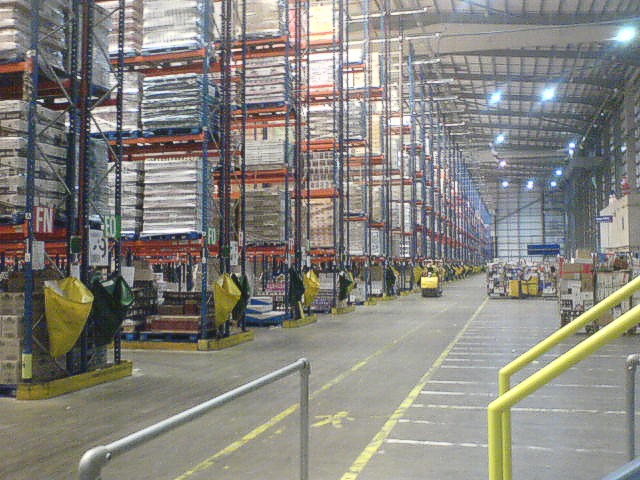
by Fronetics | Dec 16, 2014 | Blog, Supply Chain

Is your distribution center proving to be a cost center? Looking to increase profits while reducing cost? Here’s how you can transform your distribution center into a profit center.
Synchronize
Anemic communication and fractured messaging within and across departments can be very costly. Build a culture in which exceptional communication in and between departments is a central component. Establishing clearly defined expectations and promoting openness will benefit your employees and your bottom line.
Optimize space
Take advantage of your distribution center. Every single inch should be used in a strategic manner. Empty or poorly used space will quickly transform your distribution into a cost center. Inspect your distribution center with a fine-toothed comb and a healthy dose of honesty. Identify obsolete inventory and work to eliminate it. Inventory that’s not necessarily obsolete, but might not be ideal for your company, should be matched with channels that will generate revenue for these products. Ensuring the optimization of space by eliminating unused and/or outdated inventory will play a significant role in turning your distribution center into a profit center.
Embrace technology
While the cost of purchasing technology may seem insurmountable, often the cost of not adopting specific technologies is even greater. Technology can serve to increase productivity, reduce error, and improve safety. Your customers will notice and appreciate it, too.
Invest in your employees
Attract excellent employees and cultivate them. Be willing to devote time and resources to your employees. Employee turnover is expensive. The cost of replacing an employee can range from 50 to 400% of their annual salary; it will serve you well to create an environment in which your employees want to stay.
Be flexible
Flexibility isn’t just essential to growth, it’s one of the vital elements to ensuring efficient day-to-day operations of your distribution center. When your distribution center is equipped to be able to process a wide variety of goods and SKUs, your distribution is more likely to be a profit center than a distribution center, which can process only a limited number of SKUs.
Scrutinizing every aspect of your distribution processes – from the buildings to what’s in them, and from the workers to how they work – will prove to be worth the investment of time and effort as all your hard work begins to pay off, and pay out.
Let us know what strategies have worked for you.

by Fronetics | Dec 16, 2014 | Blog, Supply Chain

Is your distribution center proving to be a cost center? Looking to increase profits while reducing cost? Here’s how you can transform your distribution center into a profit center.
Synchronize
Anemic communication and fractured messaging within and across departments can be very costly. Build a culture in which exceptional communication in and between departments is a central component. Establishing clearly defined expectations and promoting openness will benefit your employees and your bottom line.
Optimize space
Take advantage of your distribution center. Every single inch should be used in a strategic manner. Empty or poorly used space will quickly transform your distribution into a cost center. Inspect your distribution center with a fine-toothed comb and a healthy dose of honesty. Identify obsolete inventory and work to eliminate it. Inventory that’s not necessarily obsolete, but might not be ideal for your company, should be matched with channels that will generate revenue for these products. Ensuring the optimization of space by eliminating unused and/or outdated inventory will play a significant role in turning your distribution center into a profit center.
Embrace technology
While the cost of purchasing technology may seem insurmountable, often the cost of not adopting specific technologies is even greater. Technology can serve to increase productivity, reduce error, and improve safety. Your customers will notice and appreciate it, too.
Invest in your employees
Attract excellent employees and cultivate them. Be willing to devote time and resources to your employees. Employee turnover is expensive. The cost of replacing an employee can range from 50 to 400% of their annual salary; it will serve you well to create an environment in which your employees want to stay.
Be flexible
Flexibility isn’t just essential to growth, it’s one of the vital elements to ensuring efficient day-to-day operations of your distribution center. When your distribution center is equipped to be able to process a wide variety of goods and SKUs, your distribution is more likely to be a profit center than a distribution center, which can process only a limited number of SKUs.
Scrutinizing every aspect of your distribution processes – from the buildings to what’s in them, and from the workers to how they work – will prove to be worth the investment of time and effort as all your hard work begins to pay off, and pay out.
Let us know what strategies have worked for you.

by Fronetics | Dec 10, 2014 | Blog, Leadership, Strategy, Talent
 Kate Lee, the senior director of research and strategy at Fronetics Strategic Advisors, has been named by Procurious as one of the 24 Most Influential People in Procurement.
Kate Lee, the senior director of research and strategy at Fronetics Strategic Advisors, has been named by Procurious as one of the 24 Most Influential People in Procurement.
The online business network for a new generation of procurement and supply chain professionals compiled the list to show who “you should be connecting with.”
Kate said she was “honored” by the recognition.
“The network and its members are not only industry leaders, but also leaders in innovation,” Kate said. “Procurious has more than 2,000 members from more than 70 countries and I’m thrilled to be part of such a niche social network.”
For the past 20 years Kate has worked with a range of people from senior executives at Fortune 500 companies to academics to refugees. At Fronetics Strategic Advisors, a management consulting firm focused on strategy and inbound marketing for the logistics and supply chain industries, Kate said she has been able to build a strong team which provides clients with unmatched service and value.
“I am proud of the team and our efforts in helping companies develop and implement inbound marketing and strategies that create results,” Kate said.
Kate is a newcomer on the Procurious list that also includes profiles such as ‘Local Producer’ AKA Brian Heinen, a driving force behind LinkedIn biggest groups for supply chain and sourcing professionals; Paul Snell, managing editor of Supply Management and Supply Business magazines; Hal Good, another LinkedIn power player in procurement with 13.5K followers on Twitter; and Tim Hughes, a top 35 UK blogger with 81.9K Twitter followers.
Procurious also cited the Fronetics Twitter account as a reason to welcome Kate into the mix.
The recognition of Kate read, in part: “The Fronetics’ Twitter account is both super-active and full of fascinating insights related to the profession.”
Kate again credited her team for the success:
“It comes down to the wonderful team at Fronetics,” she said. “We are committed to providing the industry with industry news as well as information on how to create and implement strategies that will create value.”
She continued:
“Additionally, we love engaging with individuals and companies within the industry via LinkedIn, Twitter, and our blog.”

by Fronetics | Dec 10, 2014 | Blog, Leadership, Strategy, Talent
 Kate Lee, the senior director of research and strategy at Fronetics Strategic Advisors, has been named by Procurious as one of the 24 Most Influential People in Procurement.
Kate Lee, the senior director of research and strategy at Fronetics Strategic Advisors, has been named by Procurious as one of the 24 Most Influential People in Procurement.
The online business network for a new generation of procurement and supply chain professionals compiled the list to show who “you should be connecting with.”
Kate said she was “honored” by the recognition.
“The network and its members are not only industry leaders, but also leaders in innovation,” Kate said. “Procurious has more than 2,000 members from more than 70 countries and I’m thrilled to be part of such a niche social network.”
For the past 20 years Kate has worked with a range of people from senior executives at Fortune 500 companies to academics to refugees. At Fronetics Strategic Advisors, a management consulting firm focused on strategy and inbound marketing for the logistics and supply chain industries, Kate said she has been able to build a strong team which provides clients with unmatched service and value.
“I am proud of the team and our efforts in helping companies develop and implement inbound marketing and strategies that create results,” Kate said.
Kate is a newcomer on the Procurious list that also includes profiles such as ‘Local Producer’ AKA Brian Heinen, a driving force behind LinkedIn biggest groups for supply chain and sourcing professionals; Paul Snell, managing editor of Supply Management and Supply Business magazines; Hal Good, another LinkedIn power player in procurement with 13.5K followers on Twitter; and Tim Hughes, a top 35 UK blogger with 81.9K Twitter followers.
Procurious also cited the Fronetics Twitter account as a reason to welcome Kate into the mix.
The recognition of Kate read, in part: “The Fronetics’ Twitter account is both super-active and full of fascinating insights related to the profession.”
Kate again credited her team for the success:
“It comes down to the wonderful team at Fronetics,” she said. “We are committed to providing the industry with industry news as well as information on how to create and implement strategies that will create value.”
She continued:
“Additionally, we love engaging with individuals and companies within the industry via LinkedIn, Twitter, and our blog.”

by Fronetics | Dec 9, 2014 | Blog, Supply Chain

By spending time and money on unnecessary bells, whistles, and gimmicks in an effort to delight your customers, you may be cheating yourself out of creating real value for your customers. If your current focus isn’t on your internal customer workflows, it should be. Your customers will appreciate it and you’ll benefit from building more meaningful customer relationships.
Here’s how to delight your customers and start them on the path to becoming evangelists:
1. Make it easy for your customer to do business with you.
Focus all customer-related, post sale activity on making life easier for your customer to do business — more specifically, to do business with YOU. Start by identifying any bottlenecks or delays and then find a way to eliminate them. Talk with the customer. Ask about any challenges they experienced on their end – and respond accordingly. Be the provider that makes it easier for the customer to do business; making a customer’s business run smoother will trump bells and whistles anytime.
2. Empower your employees to respond to customer queries and requests.
Your customer-facing employees are critical to customer retention and satisfaction. Make certain your employees understand the importance of their roles and work to create a culture where employees are comfortable responding to customers. Ensuring employees have the necessary support and resources to confidently interact with your customers will build value that’s likely to boost customer satisfaction rates.
3. Invest in training.
Put your time and money into training with the objective of increasing No. 1 and No. 2 above. Smart, effective employees trump all other investments on the customer satisfaction and retention scale. Looking for proof? When was the last time you were upset with a company because they were smart and efficient?
4. Delight customers to increase revenue.
Keeping existing customers satisfied is the most economical way to grow sales revenue and profits because there are no customer acquisition or startup costs. Keeping existing customers satisfied should be the mantra of your frontline employees.
5. Listen to and learn from your customers.
Query customers about their experience, their current challenges, forecasted industry trends – anything that knowing the answer to might help you serve them better. Your questions might just lead to the discovery of a new pain point that could be the catalyst for the development of a new service offering. New service offerings create opportunities to delight current customers and attract new ones.
Remember, satisfied customers tell three friends about their experience, and angry customers tell their unhappy tale to dozens. These are the interactions that can make or break an organization.
We’d love to hear your stories of excellent or subpar experiences with your vendors. Let us know what happened.



 Kate Lee, the senior director of research and strategy at
Kate Lee, the senior director of research and strategy at 